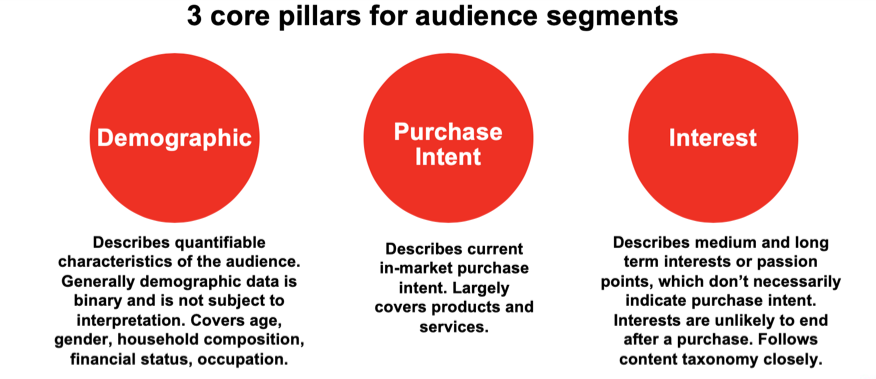Subscribe to Our Newsletter
Audience Taxonomy
About the Audience Taxonomy
The IAB Tech Lab has introduced a new set of consumer privacy features in Audience Taxonomy 1.1. The final release was made available after 30 day public comment in April 2020. For more information about the update, please read the related Tech Lab blog post. Questions and feedback can be sent to taxonomy@dev.iabtechlab.com.
Historically, data vendors, DMPs and analytics providers have used custom taxonomies to describe and segment their audiences, with little or no standardization across vendors. This results in sometimes drastically different descriptions even for similar data, where vendor A could describe a segment as “Auto-intenders” and vendor B describes a similarly segmented audience as “In-market for cars”. Comparability is also made more difficult due to the fact that in house taxonomies reflect a wide range of audience segmentation approaches, including demographic (age, gender, household income, etc), interest-based, purchase-intent based, psychographic, and many more.
With the introduction of IAB Tech Lab’s Audience Taxonomy 1.0, the industry now has a common nomenclature for audience segment names to improve comparability of data across different providers. It is a key element in IAB Tech Lab’s Data Transparency Standard (datalabel.org), which facilitates consistent labeling of audience data by first-party and third-party sources. The Audience Taxonomy also provides a mechanism to make segmentation approaches much clearer (categorically) by introducing Tier 1 level labelling that designates whether the segment describes attribution that are demographic, interest-based, or purchase-intent based. The difference between these Tier 1 categories can be thought of as follows:

A standardized approach to segment labeling has numerous use cases. Here are a few that have been submitted by the IAB Tech Lab members involved in the Audience Taxonomy development:
Use Cases
Data Vendors, Data Originators / On-boarders and Segment Creators:
- Lower Barriers to entry with an industry standard taxonomy to map to. Ease of mapping to one taxonomy for data portability across platforms.
- Consistency between relevant parts of the Audience Taxonomy and the Content Taxonomy.
- Consistency provides greater opportunity for data originators (often publishers or brands) to model and monetize audiences.
- Quality control created by the three pillars. E.g.. Interest in Cars vs. In-market purchase intent for an SUV.
- Accommodates interests which are not necessarily purchase related, but provide better opportunity for relevant marketing / brand alignment with passion points and affinity.
Data and Media Buyers:
- Ease of discovery of relevant vendors and segments
- Ability to report and compare vendors and segments like for like
- Ability to plan data and media across platforms, channels and vendors using standardised language and nomenclature
- Ease of mapping to one taxonomy for data portability across platforms, easier on-boarding of 1st party data to blend with 3rd party.
Activation Platforms:
- Many media buying platforms are now capable of optimization at a segment or data vendor level.
- Sophisticated DSPs will be able to adjust weighting / frequency of use for different audience segments and vendors in real-time. DSPs will also be able to adjust the price paid for data and / or bid prices for audience + media packages, using the taxonomy to compare similar segment performance across vendors.
About the IAB Tech Lab
Questions? Email Support Terms of Use Privacy Policy iab.com Copyright 2025 IAB Technology Laboratory, Inc.